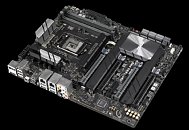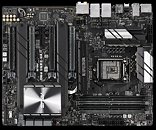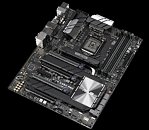- Joined
- Oct 9, 2007
- Messages
- 47,670 (7.43/day)
- Location
- Dublin, Ireland
| System Name | RBMK-1000 |
|---|---|
| Processor | AMD Ryzen 7 5700G |
| Motherboard | Gigabyte B550 AORUS Elite V2 |
| Cooling | DeepCool Gammax L240 V2 |
| Memory | 2x 16GB DDR4-3200 |
| Video Card(s) | Galax RTX 4070 Ti EX |
| Storage | Samsung 990 1TB |
| Display(s) | BenQ 1440p 60 Hz 27-inch |
| Case | Corsair Carbide 100R |
| Audio Device(s) | ASUS SupremeFX S1220A |
| Power Supply | Cooler Master MWE Gold 650W |
| Mouse | ASUS ROG Strix Impact |
| Keyboard | Gamdias Hermes E2 |
| Software | Windows 11 Pro |
ASUS expanded its Workstation motherboard series with the new WS Z390 Pro, a socket LGA1151 board based on Intel Z390 Express chipset, featuring out-of-the-box support for 9th generation Core processors. Built in the ATX form-factor, the board draws power from a combination of one 24-pin ATX, two 8-pin EPS, and an optional 6-pin PCIe power. A 10-phase VRM (likely 8+2 phase incorporating smart-doubling on the Vcore side). This board appears to be using a PCI-Express 3.0 x48 bridge chip to convert 16 gen 3.0 lanes from the CPU to two x16 downstream slots, which are further split to four x8 slots, depending on how you populate the slots. The slot configuration options are x16/x16/NC/NC or x16/x8/x8/NC or x8/x8/x8/x8. An additional open-ended x4 slot wired to the PCH makes for the rest of the expansion.
Storage connectivity includes two each of M.2-22110, and U.2 ports, each with PCI-Express 3.0 x4 wiring; and six SATA 6 Gbps ports. Networking interfaces include two 1 GbE ports, one of which is driven by Intel i219-LM, and the other Intel i210-AT. USB connectivity includes six USB 3.1 gen 2 ports on the rear panel, from which one is type-C, two additional USB 3.1 gen 2 ports by header, and a USB 3.1 gen 1 2-port header. The 8-channel onboard audio solution combines an EMI-shielded Realtek ALC S1220A codec with audio-grade capacitors, a headphones amp, and ground-layer isolation. We expect a price of around $350 for this board.




View at TechPowerUp Main Site
Storage connectivity includes two each of M.2-22110, and U.2 ports, each with PCI-Express 3.0 x4 wiring; and six SATA 6 Gbps ports. Networking interfaces include two 1 GbE ports, one of which is driven by Intel i219-LM, and the other Intel i210-AT. USB connectivity includes six USB 3.1 gen 2 ports on the rear panel, from which one is type-C, two additional USB 3.1 gen 2 ports by header, and a USB 3.1 gen 1 2-port header. The 8-channel onboard audio solution combines an EMI-shielded Realtek ALC S1220A codec with audio-grade capacitors, a headphones amp, and ground-layer isolation. We expect a price of around $350 for this board.




View at TechPowerUp Main Site




